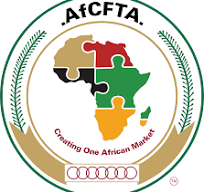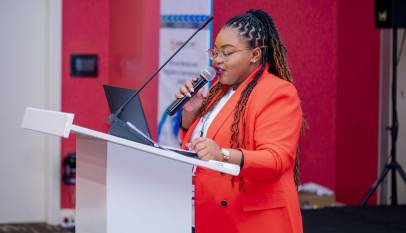SPOTLIGHT | Nteranya Sanginga: The first African chief of IITA cum brains behind its transformation
In 2011, Nteranya Sanginga became the 7th cum first African director general of the International Institute of Tropical Agriculture (IITA). A decade later, Sanginga had transformed IITA into the go-to institution for innovation and knowledge on agriculture in sub-Saharan Africa, even as the Institute emerged the first institution to win the coveted Africa Food Prize in 2018.

By Adam Alqali
The 54-year-old International Institute of Tropical Agriculture (IITA) is a brainchild of the Rockefeller Foundation and Ford Foundation aimed at expanding the 1960s Green Revolution to tropical Africa. Subsequently, IITA was established by decree 32. of 1967 of the Federal Government of Nigeria, with support from the two foundations to “provide in the tropics a high-quality international research organization devoted to finding ways as quickly as possible to increase the output and improve the quality of tropical food crops.”
In other words, IITA aims to enhance the food security, income and wellbeing of resource-poor people primarily in the humid and sub-humid zones of sub-Saharan Africa, through research and related activities aimed at increasing agricultural production, improving food systems, and managing natural resources in a sustainable manner, in partnership with national and international stakeholders.
In 1971, the Institute became part of the then Consultative Group on International Agricultural Research, now CGIAR, a global partnership of 15 international organizations focused on research around food security as well as governments, private sector and development organizations such as the Food and Agriculture Organization (FAO), the International Fund for Agricultural Development (IFAD), the United Nations Development Programme (UNDP) and the African Development Bank (AfDB), among others.
Since commencing operations in 1967, IITA has established itself as Africa’s premier Agricultural Research for Development (AR4D) nonprofit, working with international and local partners to improve livelihoods, enhance food and nutrition security, increase employment, and preserve natural resource integrity. Despite its key successes, the critical question remains: Has IITA lived up to its core vision of addressing hunger and poverty in African tropics?
Sanginga: the Congolese footballer turned international scientist
In November 2011, Dr Nteranya Sanginga became the 7th Director General of IITA and the first African to hold the topmost position at the Ibadan, Nigeria-headquartered institute. The Congolese soil microbiologist’s relationship with IITA dates back to the early 1980s; he bagged his PhD in agronomy/soil microbiology in 1985 via a joint programme between IITA and his alma mater, the Institut Facultaire des Sciences Agronomiques, (IFA-Yangambi) in Democratic Republic of Congo (DRC).
Born in 1953 at Bukavu in eastern DRC, Sanginga was raised in a poor family and grew into a skilled footballer during his primary and secondary school days, eventually becoming the best forward in DRC’s national team representing the country in an international competition in China. He ultimately gave up football to focus on his studies and graduated summa cum laude in agronomy from IFA-Yangambi in 1977, hence was retained by the institution.
In 1981, Sanginga secured a scholarship to further his studies at the University of Minnesota in the US; as providence would have it, before he left DRC for the US he had a chance encounter with a visiting soil microbiologist to IFA-Yangambi from IITA. “His lecture was so convincing, I decided I must work with this scientist and instead of going to the US, I came to Nigeria; people were making fun of me for choosing to come to Nigeria over the US,” Sanginga recollects.
After his PhD Sanginga returned to DRC to teach at his former school and was shortly thereafter headhunted by the Vienna, Austria-based International Atomic Energy Agency (IAEA), based on his PhD thesis on the use of radioactive materials to study fertility. In 1989, he left his plum job at Vienna where he (for two consecutive years) won the best staff award to return to IITA, serving in various capacities; rising from a principal scientist to become a deputy director.
In 2003, Sanginga was appointed director of the Nairobi-based Tropical Soil Biology and Fertility Institute of the International Centre for Tropical Agriculture (TSBF-CIAT). When he assumed the leadership of TSBF, the Institute had only four international scientists, 11 local staff, with a deficit budget of $1.2 million and was only operating in Kenya. By the time Sanginga left TSBF in 2011, the Institute had 29 international scientists and over 100 staff while its annual budget had risen to around $15 million with its operations expanded to east and southern Africa regions.
Becoming first African head of IITA
Around 2010, Sanginga began planning to move back home to DRC to start a project that eventually became IITA’s President Olusegun Obasanjo Research Campus in Kalambo, Bukavu. However, as fate would have it, the IITA board had in 2010 begun shopping for a replacement for the Institute’s outgoing 6th DG, Peter Hartmann. “I could never have imagined the IITA board selecting an African as the next DG of the Institute so I was not even interested in applying for the position,” Sanginga recalls.
However, the IITA chief’s reservations were not shared by his bosom friend and current president of AfDB, Dr Akinwumi Adesina. It was Adesina who ultimately nominated Sanginga for the headship of IITA and the latter eventually became one of three shortlisted candidates for the top IITA job, alongside two Americans. The 13-member IITA board (only 2 of whose members were Africans) eventually unanimously selected Sanginga as the next DG of Africa’s premier agricultural research institute.
By the time Sanginga assumed office as DG of IITA, the Institute had become a shadow of what he left in early 2000s: IITA was an institution in crisis! Other than a pending budget deficit, staff benefits were being cut and their working tools reduced to the minimum while promotions had become a rarity. Moreover, infrastructure at the hitherto serene environment of IITA’s headquarters were in a dilapidated condition. Consequently, morale was at its lowest ebb thus international and local staff alike were leaving IITA in search of greener pastures.
Dr Sanginga said his experience steering over the affairs of TSBF had taught him that people were “the wings on which an organization flies” thus not motivating employees to offer their best to their employer was tantamount to delaying the progress of an organization. Accordingly, as IITA’s DG, he adopted the “People First” strategy. “In November 2011, staff morale was very low and there was a need for a mindset change. So, we organized a town-hall meeting. There I said: ‘If you take care of IITA, IITA will take care of you!’”
The new IITA boss however found himself in a dilemma as the board had recommended downsizing IITA’s 800 staff to 500 – as a strategy for addressing the Institute’s funding deficit. “As the first African DG, my first task was sacking my African brothers but that wasn’t an option for me so I spent my first two years in office travelling across the world looking for partners and resources,” narrates Sanginga.
Transforming African agriculture through IITA
Against the foregoing, an effective strategy was necessary to address the crisis threatening the respected Institute’s reputation. Accordingly, upon assuming office on the 1st of November 2011, Sanginga set out to lead his team to develop his “People Strategy” which was the basis upon which IITA’s Business Strategy 2012-2020 was built. The subsequently adopted strategy established a core vision for IITA as the leading research institution for finding solutions to hunger and poverty in African tropics.
At the heart of this strategy was also the provision of excellent infrastructure hence the Sanginga-led IITA commenced an aggressive campaign for infrastructure development at IITA’s headquarters which sits on a 1000-ha farm estate comprising of demonstration farms, a natural preserve for birds, a tropical forest, a chain of laboratories, residential quarter, a guest house, recreational facilities, as well as a school, among others.
To make his vision for IITA a reality, Sanginga turned to his patron, former Nigerian president Olusegun Obasanjo, and his closest friend, Akinwumi Adesina, who was then Nigeria’s agriculture minister. When Sanginga became IITA’s DG, the Institute was being criticized for the lack of application and impact of its research on its supposed end users, the smallholder farmers. “So we decided that we would take IITA’s technologies and scale them to a higher level thus we created a business incubation platform including a youth programme,” he recounts.
Through its Business Incubation Platform (BIP) IITA accelerates agricultural innovations into commercial enterprises, providing agribusiness opportunities for thousands of young Africans. Sanginga is particularly passionate about young people; in 2012, he started the IITA Youth Agripreneur (IYA) initiative aimed at motivating young African graduates to become self-employed in agribusiness. Relatedly, in 2018, IITA introduced the Start Them Early Program (STEP) which inspires secondary school students to pursue agribusiness careers.
Moreover, IITA is currently the executing institution for AfDB’s flagship Technologies for African Agricultural Transformation (TAAT) programme which seeks to bridge the gap between holders of agricultural technologies as well as research organizations, government agencies, financial service providers, and the private sector so as to accelerate technologies’ deployment to farmers. TAAT is a key component of AfDB’s 2016–2025 Feed Africa Strategy itself designed by IITA.
After a decade as DG of IITA, Sanginga had transformed the Institute into the go-to institution for innovation and knowledge on agriculture in sub-Saharan Africa. Under his guidance, IITA’s budget had tripled from $35 million to $120 million while its scientists increased from 150 to 250 just as the Institute’s workforce rose from 800 to 1500. He has also significantly expanded the Institute’s research infrastructure building new laboratories and field facilities in Mozambique, DRC, Tanzania and Zambia, among others.
Thanks to his transformative leadership, in 2018, IITA became the first institution to receive the Africa Food Prize for its trailblazing research which has impacted positively on the lives and livelihoods of millions of smallholder farmers across Africa. Earlier in 2016, IITA had received the Al-Sumait Award for Food Security for its groundbreaking research for agricultural development which continues to positively impact the lives of millions of African citizens.
Despite IITA’s successes, it is not yet Uhuru for Africa as the continent continues to import $50bn food annually, despite its vast untapped agricultural potential. Additionally, the continent continues to grapple with effects of climate change, urbanisation and rapid population growth. The African Union’s Comprehensive Africa Agriculture Development Programme (CAADP) is aimed at Africa’s agricultural transformation but is yet to deliver any tangible results as countries do not adhere to its recommendation of committing 10% of their national budgets to agriculture.
“In Africa, the missing link has been political commitment. You hear African heads of state saying agriculture is a priority but if you look at their budgets, agriculture has the lowest percentage. To this end, we are creating the Africa Agriculture Leadership Institute that will work with heads of state towards changing their mindsets and building the necessary political will to transform agriculture in Africa. We already have two patrons for the Institute – former President Obasanjo and President Felix Tshisekedi of DRC,” concludes Sanginga.
Editor’s note: Dr Nteranya Sanginga will come December 11, 2021 be conferred with a traditional title by the Nigerian king, Ooni of Ife, His Imperial Majesty Oba Enitan Adeyeye, one of the most influential traditional rulers in Africa, in recognition of his contribution to agricultural research and development in Africa.













